A Relationship Hand Guide
Unlock insights into your romantic relationships through hand configurations. Discover how to identify and enhance your connections for healthier, fulfilling bonds.
Your hands teach you a lot about your romantic relationships. There are around half a dozen different hand configurations that symbolise different kinds of relationships. Listen to learn what they are so that you can identify bad ones and forge better choices to upscale the relationship you have or to develop wholesome new ones.
Thomas Budge asks the awkward questions you would like to ask, he pokes holes in rigid belief systems, and challenges the way the world taught us to think. His aim is to stimulate debate and encourage lateral thinking, so it's okay if this podcast occasionally makes you feel a little uncomfortable.
Listen to this episode here…
Click Thomas's name in the widget below to stay updated with his latest tracks and inspiring stories. Click the SoundCloud logo in the top right corner to like, leave your comments, and share your thoughts. Click the share button to let your friends discover Thom's extensive work. Every share helps amplify his voice and message.
…or perhaps, you may prefer reading it here…
Today you'll see how your hands teach you a lot about your romantic relationships. There are around half a dozen different hand configurations that symbolise different kinds of relationships. Stay right here with me as I teach you what they are. Observing this analogy will help you to identify bad relationships and teach you how to make better choices to upscale the relationship you have or to develop wholesome new ones.
Illustrations lovingly drawn by my dear friend Pamela Quin, hypnotherapist and former principal at Parktown Girls High School, Johannesburg
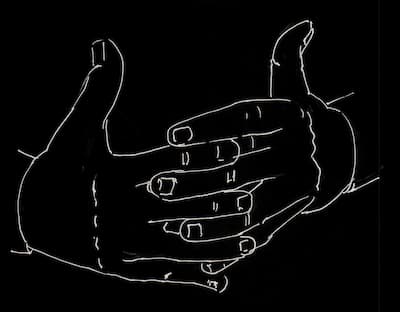
Place your hands in front of you and if you can't do that right now, just imagine it instead. Splay your fingers and look at your left hand. Pretend that this hand symbolises you. Each finger and thumb on your hand is highly symbolic and represents different aspects of your personality. These digits reach out into the world and connect with it. Every finger denotes a positive feature of who you are, your strength of character and the virtues you possess. In Soul Searching Episode 6, Jennifer Hirsch, an expert Chirologist, taught us that the fingers tell us much about one's character: your baby finger usually speaks about sexual orientation, financial exchange or a need to express yourself more authoritatively in order to be heard; the ring finger represents the extra-personal identity that you have spare, like your creativity, sportsmanship and your energy; your middle finger represents your cultural identity, your past and your sense of stability in the world; your forefinger signifies for your authority in the world, your personal identity and the way you view yourself; and lastly, your thumb symbolises your evolution to consciousness, and your personal spiritual growth. It's nice to acknowledge your strengths with gratitude but also note the gaps between your fingers. While you certainly have unique strengths, to one degree or another, you also have your own idiosyncratic weaknesses. None of us likes to admit weakness and most of us try very hard to hide it but the gaps are still there between the fingers. If your left hand in this analogy represents you, then imagine that your right hand represents another significant person in your life — your romantic partner. Just as you have strengths and weaknesses, so too does this other person. If each hand is a symbolic placeholder for the two people in a relationship, then the dynamics of the relationship are demonstrated by the way hands come together and interact with each other.
Try out the various relationship configurations for yourself in this hand analogy as we step through each of them.
Here's the first: Bring your hands together so that your fingertips touch each other — like a spider standing on a mirror. This pattern of interaction signifies a relationship where both parties have very similar strengths and weaknesses. If you try to have a relationship with a person whose strengths and weaknesses are identical to yours, you will probably clash with each other because there could be competitive pressure between the two of you — just like hands trying to push up against each other with fingers touching. In this configuration, the gaps between the fingers are always very noticeable. But there are many other ways to bring the hands together.
Here's our second configuration:
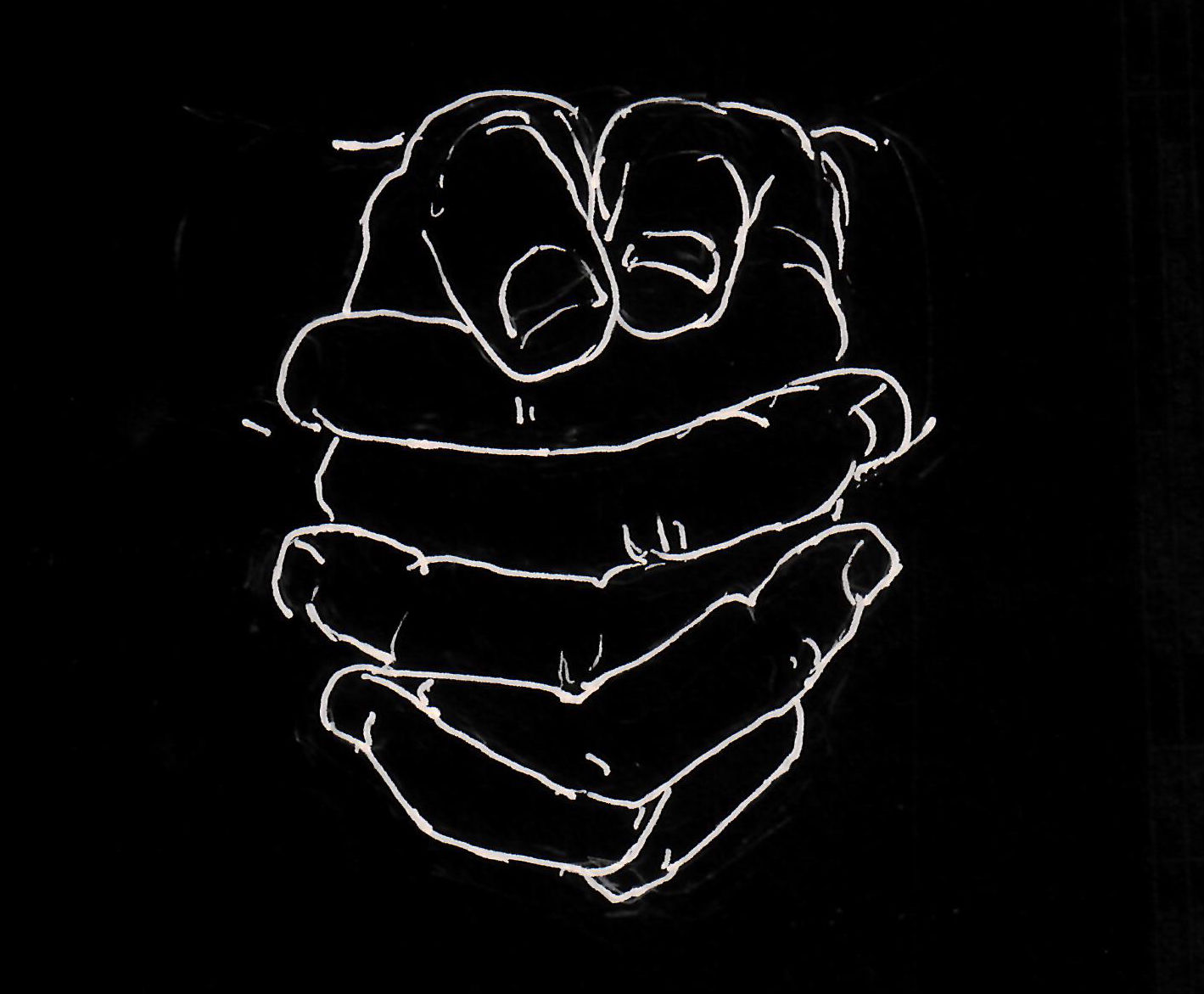
When people meet and form relationships, they often choose a partner whose strengths complement their weaknesses. If you choose a partner whose strengths offset your weaknesses and your strengths offset his or hers, you would complement each other completely. Let's represent this in our hand analogy by interlacing the fingers of both your hands so that your hands snuggle up nice and tightly. Try it out and notice how good it feels to have the fingers of each hand slide together, cosily closing the gaps between them. Most of the world's romantic partnerships are like this and we call them, "co-dependent relationships." Your strengths compensate your partner's weaknesses and vice versa. A new shape is formed when you bring your hands together with fingers and thumbs nicely interlaced, this shape demonstrates a close bond between lovers. This snug, gentle embrace between a couple, each perfectly complementing the other, is probably what was intended by the Biblical notion of holy matrimony. The hands create an inner warm and safe space between the palms. It is a well-protected, cosy nest, a home with combined material assets in which to live and perhaps even in which to raise children. As the fingers of each hand gently curl over the back of the other hand, it shows how each person in the relationship uses his or her strengths to gently protect the other person from the outside world, thereby hiding all the gaps between the fingers of both hands. If you look closely, the gaps are still there but they aren't as noticeable. In co-dependent relationships, one partner's strength offsets the other partner's weakness. It forms a beautiful synergy between people and it's not surprising therefore that most of the world's relationships are co-dependent ones. It appears that such relationships are solid and indestructible but regrettably, statistics show that around 30% of all marriages end in divorce within three years. So, what goes wrong with them? Has holy matrimony failed us?
My mum and dad were part of a generation that stayed together through thick and thin. They took their marriage vows very seriously and hung out with each other until death parted my dad and mum. No matter how immense their differences, they seemed to find a way to navigate through them and their marriage survived for 55 years. But not all co-dependent relationships are this strong.
One hand jostles with the other…
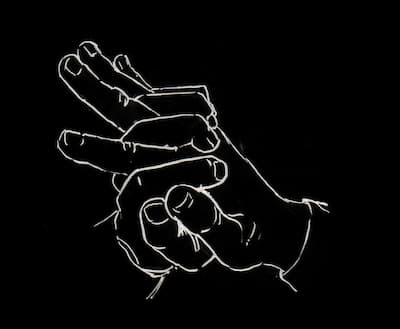
…as it tries to get the upper hand. In acts of relationship dominance, the tenderness of the clasping hands is lost and a struggle to keep balance ensues. If, for example, the right-hand bullies the left-hand by trying to flip it on its back, the left hand must fight back to keep its rightful place in the relationship. As you play this out with your own hands, notice what happens to your fingers. They squeeze tighter and there's a lot of tension and force as they try to get a firm grip. It is very natural in a bullying relationship to draw upon your strengths to outmanoeuvre or outwit your partner, and vice versa. When there is too much bullying, the left-hand may want to withdraw from the deadlock but this kind of exit out of the relationship isn't always smooth and easy to perform. Notice how the right hand can lock down, squeezing the fingers together and making it impossible for the other hand to escape. This demonstrates the claustrophobic tension that often exists between partners. As you try this out using your own hands, notice what is probably happening to the fingers of the escaping hand. They tend to straighten out while the fingers of the clasping hand tighten their grip. Tension like this is not uncommon in relationships that are falling apart. Partners don't easily uncouple when things go wrong. Should the fingers slide apart even just a little, observe the gaps that start to show up between them. Partner's weaknesses are exposed and are commonly exploited when there is tension in a relationship. But we don't like to expose our weaknesses and we will do anything in our power to cover them up. In relationships that are falling apart, there is very often a crazy need to keep contact with the bully, regardless of the magnitude of the abuse. "Better the devil you know than the one you don't know." Relationships that have nearly come to an end are like hands joined only at the fingertips. It takes but a tiny flick to pull them apart.
In a modern egoistic world, we enjoy holding on to our personal identity, as if each hand has its name written in its own palm. As the fingers of your hands come together in a co-dependent romantic partnership, the personal identities of both parties (written on the palms of the hands) are hidden. The world begins to associate with the relationship and not with the individuals that comprise it. The newly formed entity is known by its own name, "Mr and Mrs X." But in a world where maintaining one's personal identity is vital, partnerships come together with interlaced fingers, yet the pressure to maintain one's autonomy prevents the palms from meeting completely. Although the fingers try to cosy up, the palms slide sideways to expose the private label, thereby keeping the egoistic identity visible to the world. This configuration is awkward. The relationship appears to be solid from the outside but a ubiquitous ego cramps and twists it. My parent's generation seemed happy to surrender personal identity, to form a new entity, being the synergistic sum of both of them. The entity of the newly-weds met other couples and began to socialise. The entity "Mr and Mrs X" formed a friendship with the entity "Mr and Mrs Y."
Life is fluid and people are likely to change over time. It would be unrealistic to believe that neither person in a relationship will ever grow, or that they will both grow at the same rate. Here in this configuration, people's personal growth is like an adult holding hands with a very young child. Both of your hands are of similar size, making it easy for them to snuggle up but it would be very difficult for a small child to interlace his or her fingers with the hand of a rugby player. The cosy grip is then impossible to achieve. Individuals do undergo metamorphic changes in life and partners can outgrow each other. It thus takes a robust relationship to manage dynamic changes, allowing both parties to grow like neighbouring trees, independently reaching up towards the sun.
Our hand analogy is a nice way to demonstrate the dynamics of various relationships. It shows us how co-dependent ones are great, provided the couples don't jostle for power, that they are ready to surrender their personal identities in favour of the overarching new identity they get from their union and that they are ready to encourage individual, disproportionate growth.
While the majority of all relationships are co-dependent ones, there are other types of relationships on our spectrum too.
Closed finger make a fist:
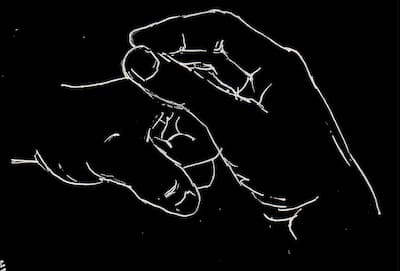
There are many people in this world who desperately lack confidence, self-worth and self-esteem. They are deeply introverted individuals. You may be one of them. They are symbolised in our hand analogy by the fingers that turn inwardly. What hope does an introverted person have in forming a meaningful relationship if his or her fingers curl up and can't reach out into the world? There are only a few possible ways for a person like this to get involved in a relationship. Introverted individuals who lack any form of self-assurance are generally very needy people.
A needy person performs acts of kindness for another in hopes of receiving some favour in return. There is the social law of reciprocity that is found in some cultures. If I offer you a glass of water, you would be expected to return the favour, if only in its simplest form by saying, "Thank you." You might run the risk of appearing ungrateful or aloof if you failed to reciprocate in this way. The law of reciprocity balances out the power in a social context. But this law is often corrupted and used to solicit favours from others. Neediness readily shows in one's body language. I once observed a man in a pub as he sat watching another guy on the other side having fun with three women. The loner had, "desperation" written all over his body and he slowly sank deeper into despair as he got drunker. The weak become easy pickings for the unscrupulous. They'll pray on them for their own gain. In our hand analogy, imagine that the tight fist of your left hand is massaging the open palm of the right hand. This symbolises a person lacking self-confidence who will do anything to win the favour of another person. Since the left-hand lacks fingers that reach into the world, the favours offered, represented by the massage, hopes to coerce the right hand into reciprocating. Even the little affirmation, "Wow, you're such a sweet person" is reward enough. The left-hand is incapable of affirming self and relies solely on the solicited affirmations of the other person to determine any form of self-value. The sad reality here is that the right-hand could pull away with ease, and often does. This leaves the left-hand isolated, dejected and without any resources of its own. Fragile individuals, symbolised by the left-hand fist, are often used by the right-hand type of person for the favours they extract from them.
IN THE FAIRYTALE STORY OF THE DAMSEL IN DISTRESS…
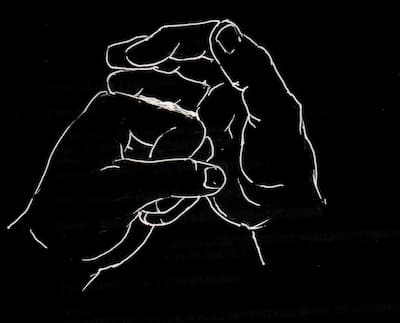
…the knight in shining armour trots up on his white stallion, whisks her up and gallops off with her to the castle where she becomes Queen. It sounds like a perfectly romantic story but there's a sadness to it. The damsel is in distress. She is like the left-hand fist without resources of her own. She waits longingly for the knight to arrive. He is her only hope. The knight, is not as vulnerable as she is. He has the protection of shining armour. He has a white stallion and is heir to the castle on the hill. He is safe. In his safety, he can scoop up any damsel of his choice yet he chooses to rescue her. Why? She becomes indebted to him forever, for without him she will not survive. He is like your right hand with fingers splayed, who scoops up the damsel, represented by your fist. She lies like a ball in this hand. He tenderly wraps himself around her. She immediately feels safe and protected. The fist, with fingers folded inwards, now has an outer wrapping. His strengths blanket her and keep her safe from the hardships of the world. But she's like a bean in a ball of damp cotton wool — a school experiment to teach children about germination. With water and sunshine, the bean soon sprouts, sending up a green stalk which quickly produces leaves. Rescue-personalities should not be surprised when the people they nurture begin to germinate, developing strengths they never had before. Play this out with your hands by resting the clenched fist of the left hand in the palm of the right hand. It's a very nurturing place for the fist to be in but, just as the bean is bound to sprout, so are the fingers of the left-hand bound to unfold and reach out into the world as confidence and esteem grow within. Notice, however, what happens to the rescuer when the fist begins to unfold. The rescuer is quickly discarded and becomes redundant. Most rescuers are unwilling to let the growth occur because they subconsciously know that their role as a rescuer will terminate the moment the introverted person regains his or her confidence, self-worth and independence. If the rescuer is incapable of taking on a new role, a nasty thing could occur: the rescuer might prune away all new growth, trapping the weaker person in a state of perpetual neediness. This may happen very subtly, "Do you really need to go out and find a job? Do I not provide enough? I want to know where you are going at all times. I need to know where you are. Tell me who are you seeing. I think you should just stay home until I arrive. I don't want you going anywhere." What began as a tender wrapping around an insecure fist, may turn into a strong, controlling squeeze. The starting point of this kind of abuse is often hard to identify but most of us know how it ends. It is very, very difficult for the resourceless fist to pull itself free from the tight and controlling grip of an abusive partner. How is the fist expected to take care of itself when it has no resources? By the time these relationships have declined into a pathological state, all the left-hand's friends are pruned away, it is systematically separated from family and stripped of any last resource. Where does it go for help? Perhaps it is better to subject oneself to the abuse instead of living on the street without resources. Sadly, these kinds of relationships are all too common. Even sadder, is that such persons, having mustered all the courage to escape an abusive relationship, are very often found entering another one where the abuse continues.
Hands are like locks and keys. There is a key here in my studio door. It fits no other lock in the building. When the tightly-held fist frees itself from the controlling grip of the abuser, it is likely to attract a similar relationship unless the lock-and-key combination is changed. The only true escape for the abused person is to come out of the relationship, seek independent help and to grow, thus changing the combination. The altered person is then less likely to repeat the same cycle and may be free to move on in life. One of Neuro-Linguistic Programming's Presuppositions is, "He who sets the frame, controls that game." This is ever so true when talking about relationships.
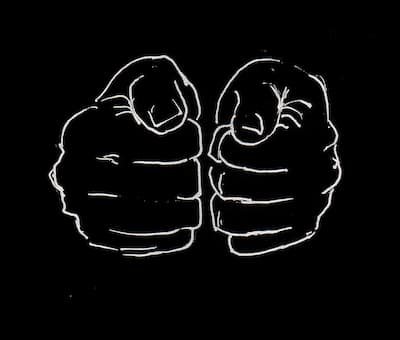
But deeply needy people, symbolised by the tight fist of your left hand, aren't always scooped up and rescued, nor do they always subject themselves to currying favour from others. It is common for the weak to be ignored, like a nerd at a party. These introverted people are often desperately lonely and become outsiders. Television soapies try to make light of characters like this. They become central characters in comedy shows: the ugly ducklings that find each other and fall in love. Two introverts in a relationship are sometimes like a couple of marbles trapped in a soup bowl — there's no escape and nowhere else to go. When both left and right hands form fists, there is little gentleness between them. They are brittle when they come together. The knuckles of one hand bump up against the knuckles of the other. I have witnessed the brutality of these resourceless relationships when both partners are in desperate need of love and respect yet neither has anything to offer. One such couple came to see me many years ago. Helped by her, it took him about 20 minutes to walk from their car to my consulting room. He was bandaged from his knees to his ankles on both legs and from his elbows to his wrists on both arms. When I asked him what had happened, he told me that they were in a fight. He was curled up in a foetal position on his back, trying to defend himself. She, with a heavy object, beat down on him with rage. She shattered some bones in his forearms and lower legs. This relationship was deeply pathological and was characterised by excessive use of alcohol that led to frequent violence. It is very important that when a relationship of yours collapses that you don't tend to drift down-bound towards the abusive relationships just because you lost a bit of your confidence.
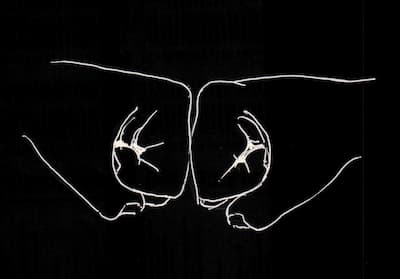
Abusive relationships happen at the lower end of the spectrum…
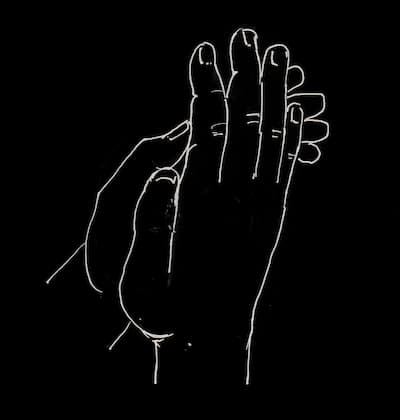
…there are also magnificent up-bound relationships too. The up-bound relationships are too beautiful to behold. To get an idea of these kinds of relationships, let's turn to our hand analogy again. This time, extend your left hand, palm open but with your fingers together and your thumb tucked up against the palm. This hand configuration represents a person who is whole, complete and content. There are no gaps between the fingers. This person has no aberrations or weaknesses. This is a person without neediness. You might be a person like this. He or she is perfectly content and happy to be alone and in the company of another. This person doesn't need another person to mask the gaps between the fingers because there are no gaps to mask. Just because the person is so perfectly content, it doesn't mean that he or she is not in a romantic relationship. When these sorts of people come together and form a relationship, it is like your hands coming together as if in prayer. These relationships lack possessiveness and control. The partners come together to experience the warm interface between them. As easily as the hands come together so can they separate too. The hands stay together because they can and not because they must. These relationships are like a well-rehearsed dance, the togetherness flows fluidly, the partners are equals in all respects. When a person is without neediness, one may say that that person like this is truly abundant.
Take note of how your hands interact with each other because they teach you much about romantic relationships and how to develop up-bound bonds with another person.


